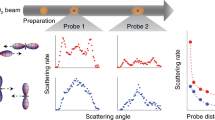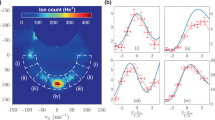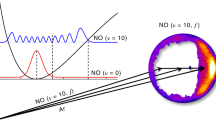Abstract
One of the most important parameters in a collision is the ‘miss distance’ or impact parameter, which in quantum mechanics is described by quantized partial waves. Usually, the collision outcome is the result of unavoidable averaging over many partial waves. Here we present a study of low-energy NO–He collisions that enables us to probe how individual partial waves evolve during the collision. By tuning the collision energies to scattering resonances between 0.4 and 6 cm−1, the initial conditions are characterized by a limited set of partial waves. By preparing NO in a rotationally excited state before the collision and by studying rotational de-excitation collisions, we were able to add one quantum of angular momentum to the system and trace how it evolves. Distinct fingerprints in the differential cross-sections yield a comprehensive picture of the partial wave dynamics during the scattering process. Exploiting the principle of detailed balance, we show that rotational de-excitation collisions probe time-reversed excitation processes with superior energy and angular resolution.

This is a preview of subscription content, access via your institution
Access options
Access Nature and 54 other Nature Portfolio journals
Get Nature+, our best-value online-access subscription
$29.99 / 30 days
cancel any time
Subscribe to this journal
Receive 12 print issues and online access
$259.00 per year
only $21.58 per issue
Buy this article
- Purchase on Springer Link
- Instant access to full article PDF
Prices may be subject to local taxes which are calculated during checkout




Similar content being viewed by others
Data availability
All data are available online at DANS: https://doi.org/10.17026/dans-x8q-pcuk.
References
Chadwick, H., Hundt, P. M., van Reijzen, M. E., Yoder, B. L. & Beck, R. D. Quantum state specific reactant preparation in a molecular beam by rapid adiabatic passage. J. Chem. Phys. 140, 034321 (2014).
Perreault, W. E., Mukherjee, N. & Zare, R. N. Quantum control of molecular collisions at 1 Kelvin. Science 358, 356–359 (2017).
McDonald, M. et al. Photodissociation of ultracold diatomic strontium molecules with quantum state control. Nature 535, 122–126 (2016).
Hu, M.-G. et al. Direct observation of bimolecular reactions of ultracold KRb molecules. Science 366, 1111–1115 (2019).
Herschbach, D. R. Molecular dynamics of elementary chemical reactions (Nobel lecture). Angew. Chem. Int. Ed. 26, 1221–1243 (1987).
Herschbach, D. Chemical stereodynamics: retrospect and prospect. Eur. Phys. J. D 38, 3–13 (2006).
Anggara, K., Leung, L., Timm, M. J., Hu, Z. & Polanyi, J. C. Approaching the forbidden fruit of reaction dynamics: aiming reagent at selected impact parameters. Sci. Adv. 4, eaau2821 (2018).
Volz, T. et al. Feshbach spectroscopy of a shape resonance. Phys. Rev. A 72, 010704(R) (2005).
Wigner, E. P. On the behavior of cross sections near thresholds. Phys. Rev. 73, 1002–1009 (1948).
Jankunas, J., Jachymski, K., Hapka, M. & Osterwalder, A. Observation of orbiting resonances in He(3S1) + NH3 Penning ionization. J. Chem. Phys. 142, 164305 (2015).
Klein, A. et al. Directly probing anisotropy in atom–molecule collisions through quantum scattering resonances. Nat. Phys. 13, 35–38 (2017).
Lavert-Ofir, E. et al. Observation of the isotope effect in sub-kelvin reactions. Nat. Chem. 6, 332–335 (2014).
Bergeat, A. et al. Understanding the quantum nature of low-energy C(3Pj) + He inelastic collisions. Nat. Chem. 10, 519–522 (2018).
Bergeat, A., Onvlee, J., Naulin, C., van der Avoird, A. & Costes, M. Quantum dynamical resonances in low-energy CO (j = 0) + He inelastic collisions. Nat. Chem. 7, 349–353 (2015).
Bergeat, A., Morales, S. B., Naulin, C., Wiesenfeld, L. & Faure, A. Probing low-energy resonances in water-hydrogen inelastic collisions. Phys. Rev. Lett. 125, 143402 (2020).
de Jongh, T. et al. Imaging the onset of the resonance regime in low-energy NO-He collisions. Science 368, 626–630 (2020).
Onvlee, J., van der Avoird, A., Groenenboom, G. & van de Meerakker, S. Y. T. Probing scattering resonances in (ultra)cold inelastic NO–He collisions. J. Phys. Chem. A 120, 4770–4777 (2016).
Amarasinghe, C. et al. State-to-state scattering of highly vibrationally excited NO at broadly tunable energies. Nat. Chem. 12, 528–534 (2020).
van de Meerakker, S. Y. T., Bethlem, H. L., Vanhaecke, N. & Meijer, G. Manipulation and control of molecular beams. Chem. Rev. 112, 4828–4878 (2012).
Eppink, A. T. J. B. & Parker, D. H. Velocity map imaging of ions and electrons using electrostatic lenses: application in photoelectron and photofragment ion imaging of molecular oxygen. Rev. Sci. Instrum. 68, 3477–3484 (1997).
Aoiz, F. J. et al. Inelastic scattering of He atoms and NO(X2Π) molecules: the role of parity on the differential cross section. J. Phys. Chem. A 113, 14636–14649 (2009).
NIST Handbook of Mathematical Functions Paperback and CD-ROM (Cambridge Univ. Press, 2010).
Bolzmann, L. Weitere studien über das wärmegleichgewicht unter gasmolekülen. Wien. Ber. 66, 275–370 (1872).
Einstein, A. Strahlungs-emission und -absorption nach der quantentheorie. Verh. Deutsch. Phys. Ges. 18, 318–323 (1916).
de Jongh, T. et al. Imaging the onset of the resonance regime in low-energy NO-He collisions. Science 368, 626–630 (2020).
Yan, B. et al. A new high intensity and short-pulse molecular beam valve. Rev. Sci. Instrum. 84, 023102 (2013).
Ball, C. D. & De Lucia, F. C. Direct observation of Λ-doublet and hyperfine branching ratios for rotationally inelastic collisions of NO-He at 4.2 K. Chem. Phys. Lett. 300, 227–235 (1999).
Even, U. Pulsed supersonic beams from high pressure source: simulation results and experimental measurements. Adv. Chem. 2014, 636042 (2014).
Plomp, V., Gao, Z. & van de Meerakker, S. Y. T. A velocity map imaging apparatus optimised for high-resolution crossed molecular beam experiments. Mol. Phys. 119, e1814437 (2021).
Scharfenberg, L., van de Meerakker, S. Y. T. & Meijer, G. Crossed beam scattering experiments with optimized energy resolution. Phys. Chem. Chem. Phys. 13, 8448–8456 (2011).
von Zastrow, A. et al. State-resolved diffraction oscillations imaged for inelastic collisions of NO radicals with He, Ne and Ar. Nat. Chem. 6, 216–221 (2014).
Acknowledgements
This work is part of the research programme of the Netherlands Organization for Scientific Research. S.Y.T.v.d.M. acknowledges support from the European Research Council under the European Union’s Seventh Framework Program (FP7/2007-2013/ERC grant agreement no. 335646 MOLBIL) and from the European Research Council under the European Union’s Horizon 2020 Research and Innovation Program (grant agreement no. 817947 FICOMOL). We thank N. Janssen and A. van Roij for expert technical support. We thank F. J. M. Harren for stimulating discussions regarding the optical excitation of NO using a quantum cascade laser. We thank T. Karman for fruitful discussions and for critically reading the manuscript.
Author information
Authors and Affiliations
Contributions
The project was conceived by S.Y.T.v.d.M. The experiments were carried out by T.d.J., Q.S. and S.K. Methods to rovibrationally excite NO using a quantum cascade laser were developed by G.A. and Q.S. Data analysis and simulations were performed by T.d.J. Theoretical calculations were performed by M.B., A.v.d.A. and G.C.G. The manuscript was written by T.d.J. and S.Y.T.v.d.M. with contributions from all authors. All authors were involved in the interpretation of the data and the preparation of the manuscript.
Corresponding authors
Ethics declarations
Competing interests
The authors declare no competing interests.
Peer review
Peer review information
Nature Chemistry thanks Astrid Bergeat and the other, anonymous, reviewer(s) for their contribution to the peer review of this work.
Additional information
Publisher’s note Springer Nature remains neutral with regard to jurisdictional claims in published maps and institutional affiliations.
Supplementary information
Supplementary Information
Supplementary Figs. 1–11, Tables 1–3, Methods and Results.
Rights and permissions
About this article
Cite this article
de Jongh, T., Shuai, Q., Abma, G.L. et al. Mapping partial wave dynamics in scattering resonances by rotational de-excitation collisions. Nat. Chem. 14, 538–544 (2022). https://doi.org/10.1038/s41557-022-00896-2
Received:
Accepted:
Published:
Issue Date:
DOI: https://doi.org/10.1038/s41557-022-00896-2



